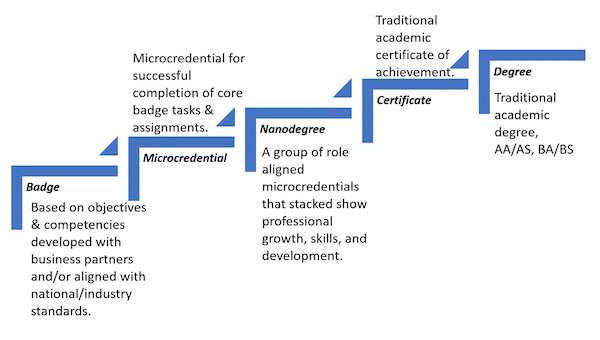Published on
Microcredentials Forge the Links Between Businesses, the Community and their College

To respond to the changing requirements of postsecondary learners and workers, higher education must shift away from the all-or-nothing model that puts firm distinctions between credit (leading to a degree) and non-credit (supporting the workforce) programming.
It’s time to develop smaller, more discrete credentials like badges, microcredentials, and nanodegrees, where credit can be assigned and collected in smaller formats and then applied to longer-term traditional degree models. Community colleges need to shift their learning strategy to embrace not only degree completion, but also content completion, which can provide employers with the talent they need, when they need it.
To accomplish this, community colleges must target the relationships they already have with their local communities. As Van Ton-Quinlivan, California Community Colleges’ Executive Vice Chancellor of Workforce and Digital Futures, says, “Staying current means partnering with employers.” Such partnerships maximize the impact that community colleges can have by understanding local workforce needs and supporting the local community.
This results in a dynamic partnership where the real-world skills and competencies needed in the workplace are reflected in course content—and, more importantly, in the authentic assessment strategies used to determine the level of proficiency that students must meet. Such an approach aligns the classroom evaluation with an employer’s real world rubric.
The time is right to create this extended learning strategy. Working learners are continuing to add to their professional skills, and are actively seeking out professional development programming. Community colleges have a real opportunity to leverage the development and delivery of smaller learning modules, which their partners in the workforce can use as a strategic business tool to engage and retain skilled workers.
A recent report shared that a primary driver for Millennial workers is job development. A Gallup study revealed that “87 percent of Millennials [stated] development is important to them in a job. PwC similarly found that that over half of Millennials report [the] ‘ability to grow and progress through the organization’ as the primary attraction to an employer.”
Given this, community colleges can leverage their offerings to create learning opportunities that align with job development goals. They can develop new pathways for their existing credentials by creating smaller microcredentials that could accumulate into broader academic earnings. This “learning ladder” would include a credit model where smaller modules, such as badges, would have a credit equivalency that could be collected and leveraged as a microcredential that could be added to a nanodegree.
From here, a working learner could apply those nanodegrees to certificate programs, and ultimately complete a degree. Drawing on the strength of their existing relationships with local employers, community colleges could collaboratively develop content that teaches employer-defined skills and competencies in shorter modules, with the goal of meeting current and future talent needs.
By working with employers, community colleges could ensure that their curriculum is cross-walked against industry standards and/or current best practices. Working together would streamline the curriculum review process, whereby modular content that meets business needs could be assessed and assigned credit value. Additionally, faculty could design smaller, competency-based learning modules where demonstrating proficiency in a given professional skill set could be aligned with a robust rubric for evaluation and grading. This would enable students to begin the building of a bank of credits that could be used to progress up the ladder of learning while developing professional competencies.
Additionally, this would allow community colleges to strengthen their position as the go-to resource for professional development. Faculty developing these smaller, credit-awarded content modules could work with employers to look at ways to develop and impact employees going forward. Much like designing a curriculum map, this opportunity centers on creating a career path with the employer that could be aligned with the learning ladder and maximize the knowledge resources offered by both the college and the employer. This shared development plan would provide the tight connection between employer-based subject matter experts and institutionally-based relevant faculty.
This looks simple from the perspective of technical skills and content-specific techniques, but how will other academic programs fit in? Easily, if the message being sent by business is heard. The Future of Work Global Research Study 2018 identified that, “leadership agility was by far the most important characteristic employees must have to be competitive today, followed by coordinating with others. Creativity and communication skills were ranked third and fourth respectively, with very little in the difference, while an eagerness to learn and negotiating with others were next on the list.”
How can these “soft skills” be integrated into community college programming? One example would be creating badges that center on specific skills like writing, verbal communication, and presenting. As additional badges are acquired at a defined level of proficiency, they could become the equivalent of a traditional “course” that could then be applied to the completion of a certificate or degree.
The landscape is changing. Creating a more robust array of smaller credentials that recognize the needs of local employers and lead to certificate and degree completions will enable community colleges to deepen existing partnerships and create new connections between content and context. Now is the time for community colleges to leverage existing institutional capacities to develop and deliver a streamlined curriculum to modern working learners.
Author Perspective: Community College
Author Perspective: Analyst




